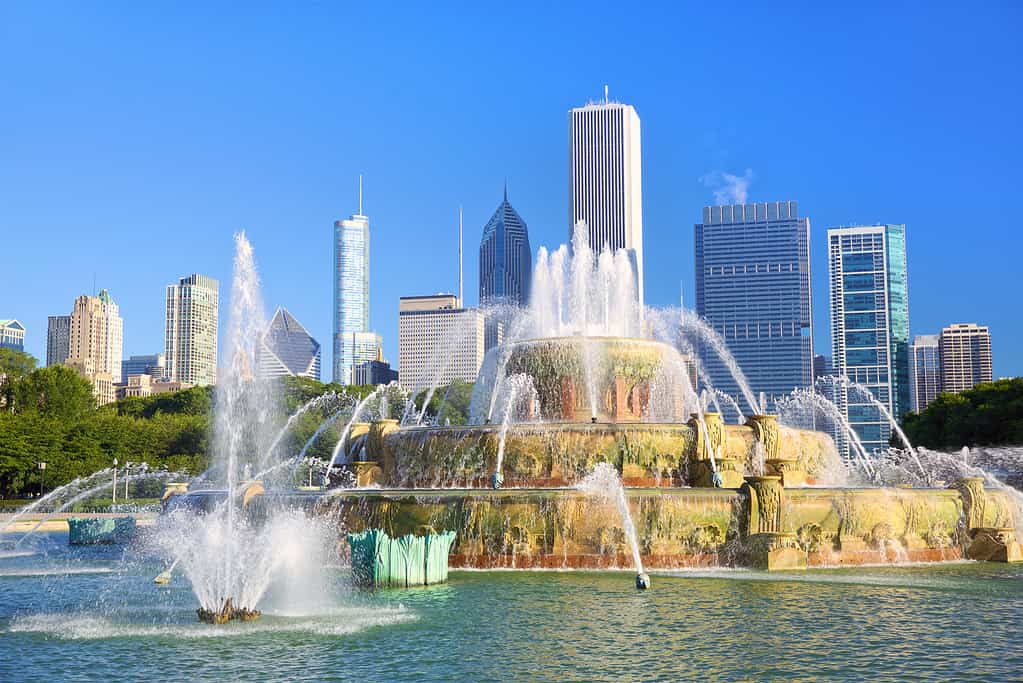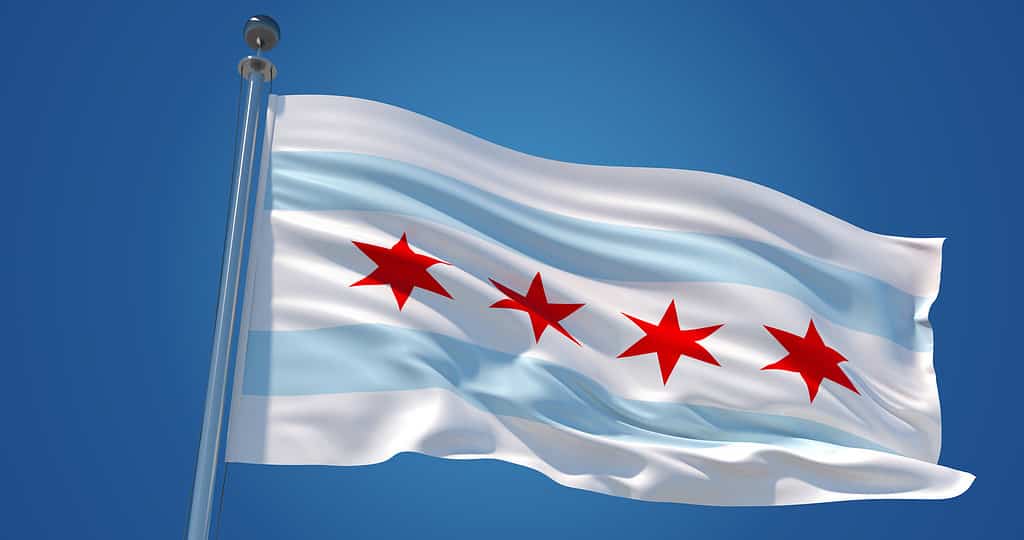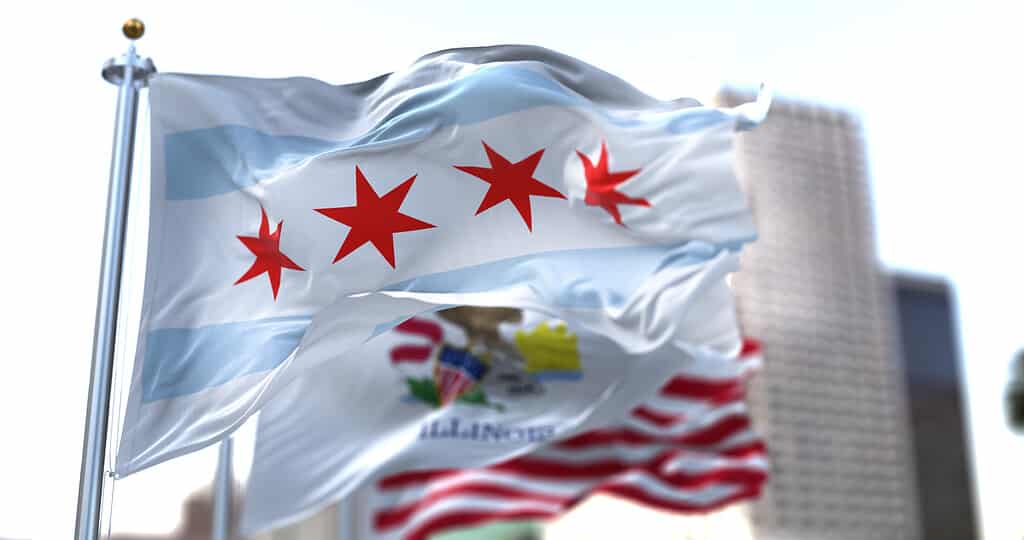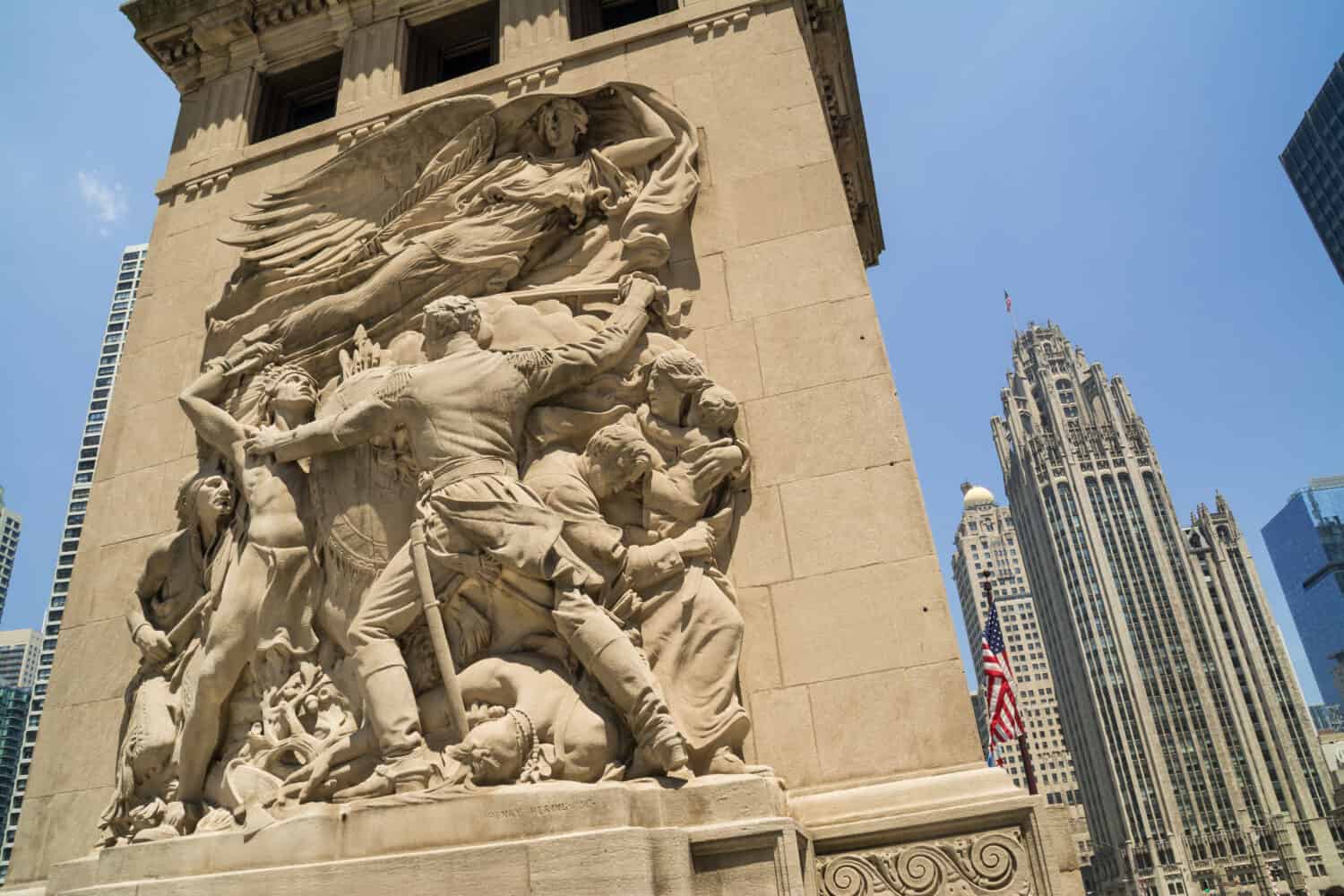The flag of Chicago is a beloved symbol featured prominently in many locations throughout the Windy City. Here we explore its elements to understand Chicago’s unique history, values, and spirit.
About Chicago

Buckingham Fountain is in Grant Park, one of Chicago’s attractions/
©dibrova/iStock via Getty Images
Chicago is a vibrant and diverse city located in the heart of the Midwest. With a population of over 2.7 million people, it is the third-largest city in the United States and the largest city in the state of Illinois. This is pretty amazing, considering that in 1833, less than 200 persons lived there!
Chicago is a city of culture with a wide variety of attractions to explore. Visitors can explore the city’s iconic skyline, the world-famous Navy Pier, and the city’s many museums, galleries, and theaters. The city also boasts miles of lakefront trails, parks, and beaches and a vibrant nightlife.
Chicago is also home to a number of professional sports teams, such as the Chicago Bears, Chicago Bulls, Chicago Cubs, Chicago White Sox, and the Chicago Blackhawks. The city also hosts many major sporting events, such as the Chicago Marathon, the Chicago Triathlon, and the Chicago Marathon.
The city of Chicago is also a great place to live, work, and play. Chicago has a thriving economy, with industries ranging from finance and technology to manufacturing and transportation. The city also has a strong educational system, with several top universities, such as the University of Chicago and Northwestern University.
Chicago is a great city to visit and explore. Whether you are looking for a family-friendly destination, a lively nightlife, or a place to explore the culture and history of the Windy City, Chicago has something to offer everyone.
The Flag of Chicago

As one of the few cities with its own flag, the city of Chicago is very proud of the Flag of Chicago.
©Maksym Kapliuk/iStock via Getty Images
The flag of Chicago, a prominent symbol of the city’s identity and history, is composed of several distinct elements that hold deep meaning. The flag, designed in 1917 by Wallace Rice, a renowned poet and artist, showcases a simple yet powerful design.
At first glance, one cannot miss the vibrant portrayal of two light blue horizontal bars stretching across a field of pure white. These bars are precisely sized to be one-sixth the height of the full flag and are strategically positioned slightly less than one-sixth from both the top and bottom edges. This deliberate placement creates an aesthetically pleasing balance while conveying a sense of harmony.
Taking center stage on this striking backdrop are four bold red stars, each adorned with six sharp points. Placed side by side within the middle third portion of the flag’s surface, these stars proudly represent significant historical events that have shaped Chicago’s narrative.
History
In 1915, Mayor William Hale Thompson created a committee for the purpose of making a flag for the city of Chicago. It was headed by Alderman James A. Kearns and included Charles Deering, a wealthy businessman, and Lawton S. Parker, a painter. Wallace Rice, a lecturer and poet, was tasked with establishing guidelines for an open competition for the best design. Over a thousand people submitted their submissions! The flag became so important to Chicago that the 318th Cavalry Regiment used the chosen design in its own insignia.
In 1917, the design created by Wallace Rice was chosen in a competition held by the City Council and adopted as the city flag. Initially, it had two stars, but a third was added in 1933. Finally, the city adopted the four-star version in 1939. The North American Vexillological Association assessed 150 American city flags and placed Chicago’s flag as the runner-up with a score of 9 out of 10 – just behind the winning flag of Washington, D.C.
Symbolism and Meaning of the Flag of Chicago

As patriotic symbols go, the flag of Chicago is one of the best!
©rarrarorro/iStock via Getty Images
The flag of Chicago, Illinois, is an iconic symbol of the city. It features four red stars arranged in a straight-line pattern across a field of white, with two blue stripes running horizontally across the hoist and fly. The creators chose six-pointed stars because stars with five points represent sovereign states. They also like the fact that no other flag with this type of star existed yet in 1917.
First Star
This star is original to the first 1917 version of the flag. It stands for the Great Chicago Fire that burned the city in 1871.
This event was a devastating conflagration that burned from October 8 to October 10, 1871, destroyed thousands of buildings, killed an estimated 300 people, and left 100,000 people homeless in the city of Chicago. The fire started on the evening of October 8 and quickly spread, fueled by a strong wind and the mostly wooden buildings in the city. The cause of the fire is still unknown, though various theories have been proposed. The fire caused an estimated $200 million in damages.
Each point of the first star also has meaning. The six points stand for:
- Populousness
- Healthfulness
- Industry
- Finance
- Trade
- Transportation
Second Star
The second star is also original to the 1917 Chicago flag. This star is a symbol of the World’s Columbian Exposition in 1893.
The was a world’s fair of immense scale and grandeur. It featured over 200 buildings filled with art galleries, exhibits, and demonstrations showcasing the latest technological advancements and cultural achievements from around the globe. Attendees were awed by the fair, which also featured music and dance performances and showcased exotic animals and plants from distant lands. It was an event of tremendous scope and impact, leaving a lasting impression on the city of Chicago and beyond.
The six points of this second star are symbols of:
- Civism
- Justice
- Beneficence
- Aesthetics
- Education
- Religion
Third Star
The fourth star in the Chicago flag represents the 1933 Century in Progress Exposition. It was proposed and approved that same year.
The 1933 Century of Progress Exposition in Chicago was a world’s fair hosted by the city of Chicago to celebrate the centennial of its founding. It showcased the latest advances in science, technology, industry, and culture from around the world. The fair featured many exhibits, including a replica of the first Ferris wheel, an artificial waterfall, and a Formosa Village with a variety of Chinese exhibits. Other attractions included a large amusement park, a Hall of Science, and a Hall of Social Science. The fair was a great success and was visited by millions of people from around the world.
When this star was added, it was in celebration of the fact that Chicago was the 2nd biggest city in the country. The six points of the star are symbols of the dominating governments that were controlling the land at the time. They are:
- Illinois Statehood (1818)
- Indiana Territory (1802)
- Northwest Territory (1798)
- Virginia (1778)
- Great Britain (1763)
- France (1673)
Fourth Star

This monument stands in Chicago as a remembrance of those who lost their lives in Fort Dearborn.
©Eddie J. Rodriquez/Shutterstock.com
In 1939, Chicago added a fourth and final star to their flag. It symbolizes the American military fort built in 1803, Fort Dearborn.
Fort Dearborn is a very important part of Chicago’s history, located near the city’s downtown area along the Chicago River. It was established in 1803 by the United States Army and was a major trading post and military fort. It was named after Henry Dearborn, the Secretary of War. During the War of 1812, Fort Dearborn was attacked by Native American forces, resulting in the Massacre of Fort Dearborn. The fort was eventually abandoned in 1837, but the area was later settled and is now the site of a monument and historical marker commemorating the fort and its history.
The six points on this star stand for important mottos and nicknames used by the city over the years. They are:
- The Convention City
- The Wonder City
- The Great Central Market
- “I Will” Spirit
- World’s Third Largest City
- Urbs in Horto (which is Latin for City in the Garden).
Colors
The colors of the flag have specific meanings as well. The white symbolizes peace and unity. The flag designer wanted Chicago to be a land where all nations could dwell in peace. The topmost white strip stands for the North Side and the Atlantic Coast. The middle white stripe stands for the West Side and for the great Central Plains. The bottommost white stripe is a symbol of the South Side and the Pacific Ocean.
While the blue is an homage to the Great Lakes and the city’s strong ties to the water. The red symbolizes the strength and courage of the citizens of Chicago and their resilience in the face of adversity.
The photo featured at the top of this post is © Maksym Kapliuk/iStock via Getty Images
Thank you for reading! Have some feedback for us? Contact the AZ Animals editorial team.






